(written from a Production point of view)
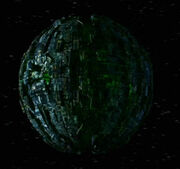
Borg sphere
Following on from the sophisticated Borg type 03, showcased once in the Star Trek: The Next Generation season seven episode "Descent, Part II", the Borg sphere was the first "simple shape" devised as an alternative design of Borg spacecraft to the Borg cube and cubical Borg scout ship. The writers of Star Trek: First Contact, in which the sphere was introduced, were originally very eager for the visual impact of a brand new form of Borg ship and it was thereafter decided that a sphere-shaped vessel was the way to go. (Star Trek: The Official Starships Collection, issue 10, p. 12) Brannon Braga, a co-writer of First Contact, mused, "The idea that we would introduce that Borg ships had different shapes. They weren't all cubes. We have a sphere. It was like this great new idea, you know?" (Star Trek: First Contact (Special Edition) DVD/Blu-ray, audio commentary)
Design[]

Delgado's initial Borg sphere concept
Designers of the Borg sphere were concerned it might look too much like the Death Star from Star Wars. Many discussions were had about this issue, conversations in which illustrator John Eaves, who was ultimately most directly responsible for designing the Borg sphere, participated. ("The Borg Collective: Design Matrix", Star Trek: First Contact (Special Edition) DVD/Blu-ray; Star Trek: The Official Starships Collection, issue 10, p. 12) Someone else present sarcastically commented that nobody would remember the Death Star. Joking aside, anxiety about the Borg sphere's resemblance to that iconic, militaristic space station remained, especially considering that the much-hyped movie Star Wars: Episode I The Phantom Menace was also being made at the time. "The sphere came out where we had to redesign it, where it wouldn't be Death Star-ish," noted Eaves. ("The Borg Collective: Design Matrix", Star Trek: First Contact (Special Edition) DVD/Blu-ray) Production Designer Herman Zimmerman described this issue as "our biggest problem" and "our biggest challenge." (The Making of Star Trek: First Contact, p. 71; Star Trek: The Official Starships Collection, issue 10, p. 12) In essence, everyone was determined to ensure the Borg sphere looked unique. (Star Trek: The Magazine Volume 1, Issue 23, p. 51) Initially, an alternative design of Borg sphere was suggested in artwork by illustrator Ricardo Delgado, who made his version look radically different to anything seen before. One half of the sphere's hull would be composed of traditional Borg panels, whereas the other half would be a force field containing a gaseous energy that the sphere used for fuel. (Star Trek: The Magazine Volume 1, Issue 23, p. 53)
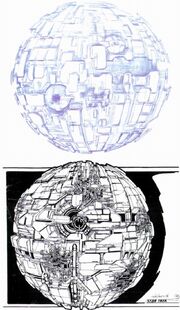
Eaves' initial design concepts
The design team's interest in distinguishing the Borg sphere from the Death Star became a central influence in devising the former vessel's configuration. "So we came up with a shape that has very, very deep facets," said John Eaves, toward whom the design work gravitated, "More like sections of an apple, cut, with big open cores on either end. And that's kind of where the design essence came from." ("The Borg Collective: Design Matrix", Star Trek: First Contact (Special Edition) DVD/Blu-ray) The minute detailing on the Borg sphere's hull, however, took its cue from that on the hull of the Borg cube from Star Trek: The Next Generation. Stated Eaves, "We [...] left cylindrical openings at the north and south poles where all the detail comes to an edge, then cascades down into a half sphere. Looking down on it, you can see a 'dome inside a dome.'" (Star Trek: The Next Generation Sketchbook: The Movies, p. 204) Eaves presented a series of concept drawings for Herman Zimmerman and Producer Rick Berman to review. These sketches, at least the first two of which were dated January 1996, were drawn and submitted during pre-production on First Contact. (Star Trek: The Magazine Volume 1, Issue 23, p. 51; Star Trek: The Next Generation Sketchbook: The Movies, pp. 204-206) The design process was a fairly short one, though it explored several directions that were ultimately rejected. "At one point, it was going to be little spheres inside of a sphere," said Eaves, "then it grew away from that." The original illustration John Eaves drew of the Borg sphere was a sketch in blue ink. "My first drawing was of a staggered puzzle-piece looking sphere," he remarked. "It had a little escape pod inside of it and you could see this kind of undersphere under the surface. That was a good direction; Herman and Mr. Berman liked it. They told me to keep going and to keep the shapes really irregular; they didn't want any mathematical patterns whatsoever." (Star Trek: The Magazine Volume 1, Issue 23, p. 51)
John Eaves proceeded with his second pass, making the detailing on the hull slightly more random than first conceived. "I took it a little bit further, and made the next one with really raised surfaces and very inset surfaces," explained Eaves. (Star Trek: The Magazine Volume 1, Issue 23, p. 51) In the same concept illustration, he hid the names of his wife Diane and his two daughters, Olivia and Alicia, among the sphere's extremely intricate outer details. Eaves added, "What's funny about this is that Playmates put out a toy Borg sphere – which just happens to contain the first initial of everyone's name." (Star Trek: The Next Generation Sketchbook: The Movies, pp. 205 & 215) Based on the plot point that the sphere was to be depicted as firing on Bozeman, Montana from overhead, John Eaves outfitted his second sketch of the sphere with a large weapons platform, represented by a series of rings on the hull that appeared to recede deep inside the vessel. Although this second drawing was generally almost exactly what the quality control group was looking for, everyone had an issue with the illustration of the weapons platform. "They wanted an open hole with some rings, but that did look too like the Death Star," remembered Eaves, "so we got rid of it." (Star Trek: The Magazine Volume 1, Issue 23, pp. 51 & 53)
John Eaves did one final drawing of the Borg sphere. Featuring heavy paneling and exposed pipes, this illustration was colorized and, as far as Eaves could see, it seemed to please Herman Zimmerman and Rick Berman. (Star Trek: The Magazine Volume 1, Issue 23, pp. 52 & 53) The final design of the Borg sphere retained the "sphere inside a sphere" concept as well as the circular opening for the ship's firing mechanism. However, both are considerably difficult to identify and the weapons port was covered by paneling. (Star Trek: The Magazine Volume 1, Issue 23, pp. 51 & 53)
Apart from the layout of the vessel, another method used by the designers in their efforts to individualize the Borg sphere related to its movements. John Eaves explained, "We thought if we added a a little bit of a spin to it, it would take away from the static, locked-off shot; the Death Star, you always see coming in. So we thought if we add some motion to it, maybe change the colors, and the deep facets would take it away from being an easy, recognizable shape." ("The Borg Collective: Design Matrix", Star Trek: First Contact (Special Edition) DVD/Blu-ray) In the end, the team tried to contrast the Borg sphere from not only the forenamed facility from Star Wars but also another spherical craft from the film Starman. Eaves recalled, "Finding a new way to execute a spherical design that wasn't reminiscent of either film was difficult, but I did my darnedest to make it as different as possible." (Star Trek: The Next Generation Sketchbook: The Movies, p. 204) Herman Zimmerman concluded, "I think we managed that successfully. We just made it look completely different. The Borg, of course, have a unique look, and we Borgified that sphere." (The Making of Star Trek: First Contact, p. 71)
Studio models[]
The Borg sphere started out as a traditional, physical studio model. However, advances in computer technology resulted in the addition of a digital one as well, especially once it was decided that the Borg were to play a major role in the television series Star Trek: Voyager.
Physical studio model[]
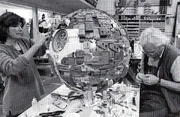
|
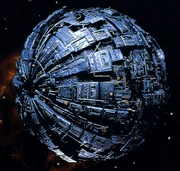
|
The external complexities of the Borg sphere meant it was easier to depict realistically with a studio model than with CGI. (Cinefantastique, Vol. 28, No. 6, p. 23) Shortly after Industrial Light & Magic model-maker John Goodson was appointed to lead the task of constructing the model, he received a phone call from John Eaves, in which Eaves expressed that they needed to do everything they could to make the sphere look new and interesting. (Star Trek: The Magazine Volume 1, Issue 23, p. 51)
The model of the Borg sphere was two feet in diameter. "We vacuformed about fifteen different patterns that conformed to this spherical curve, and covered those with a lot of molded and cast pieces," explained John Goodson. "Then we added tons of acid-etched brass over it, just like we had on the cube." (Cinefex, No. 69, p. 109) As well as Goodson, team members Barbara Affonso and Giovanni Donovan also worked on the model. (Cinefex, No. 69, p. 108) Despite appearing dark gray on screen, the model was actually painted mainly dark indigo (with silver and gold details). (Star Trek: The Next Generation Sketchbook: The Movies, p. 204)
As of 2012, the original "Borg Sphere" physical studio model, virtually unmodified and having escaped the 40 Years of Star Trek: The Collection and It's A Wrap! auctions, was still in the possession of CBS Consumer Products. The miniature has been on tour displays (such as Star Trek World Tour, Star Trek: The Adventure, and Star Trek: The Exhibition) as late as 2012. [1]
CGI studio model[]
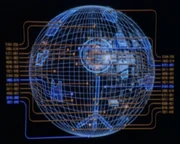
Borg sphere schematics
The depictions of Borg spheres in Star Trek: Voyager were impacted by a quickly made decision to portray all of the series' Borg vessels with CGI models. [2](X) The first time the sphere was called upon to make an appearance in the Voyager series was in the fifth season episode "Drone". It was Koji Kuramura of Foundation Imaging who digitally revamped the vessel as a CGI model which made its premiere in that episode. (Star Trek Monthly issue 58, p. 46) The schematic of a Borg sphere, a pre-production wire-frame CGI model – shown as a USS Voyager operations graphic in Voyager's later fifth season double episode "Dark Frontier" – depicted the craft's most striking resemblance to the Death Star.
Appendices[]
Further reading[]
- Star Trek: The Next Generation Sketchbook: The Movies, 1998, Chapter "The Borg Sphere and Cube", pp. 204-219
- "Designing Borg Ships", John Eaves/Larry Nemecek, Star Trek: The Magazine Volume 1, Issue 23, March 2001, pp. 50-58
- Star Trek: The Official Starships Collection, issue 10
